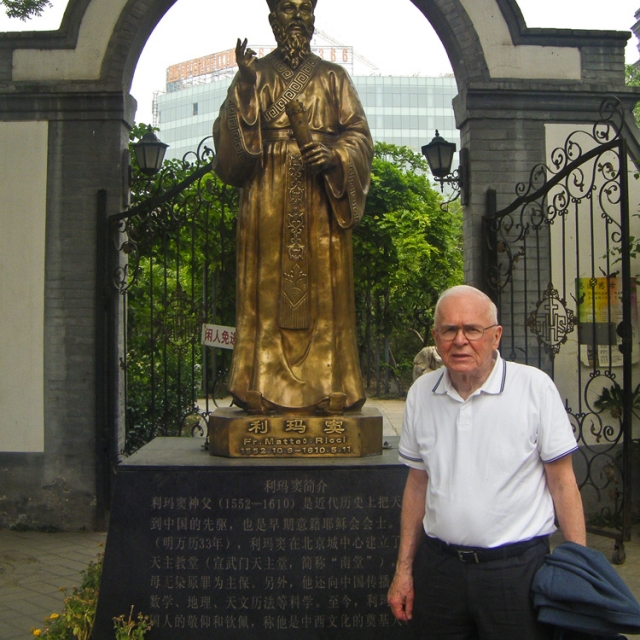Ricci came to the attention of the Emperor Wanli, who was impressed that the Jesuit tried to bring some Chinese traditions, such as the language, into the liturgy. But controversy erupted over other Chinese practices that Ricci tried to introduce, such as the burning of incense to honour ancestors. The Vatican said no.
Unfortunately, despite Ricci’s efforts, the Catholic Church was branded as European and the Emperor lost interest. Who knows what the position of the Church, now the tiniest minority, might be in today if Ricci’s vision had prevailed? That is what I felt, as I remembered with awe, the courage of Matteo Ricci.
The familiar strains of “Here I am, Lord” greeted me as I entered Sacred Heart Cathedral at Ashok Place in New Delhi. It was Ascension Sunday and the priest spoke of the need to carry the Gospel around the world.
In my own way, I thought, that is what I am trying to do in talking to audiences in many places of the need to eliminate the evil of nuclear weapons.
As I looked around the church, the bearded men, the women in bright saris, the well-scrubbed youngsters all reminded me of the timelessness of the Sermon on the Mount. Jesus’ message of how to live in peace and love rang through my mind as the priest elevated the Host, a binding moment with God and the people around me.
Afterwards, I went to the adjacent bishop’s house to meet Archbishop Vincent Concessao, the successor to my good friend, the late Archbishop Angelo Fernandes. He invited me for tea and we talked of the difficulties of the Church in India. Though Christianity in India dates back to the arrival of St. Thomas in Kerala in the first century, Christians today account for only 2.3 per cent of the enormous population of India, on track to overtake China as the most populous country in the world.
China and India make up more than a third of the world’s population, yet Christ is largely unknown in these vast lands. While I felt a communion with Indian Catholics, I felt also for their loneliness.
The next Sunday found me at St. Eric’s Cathedral in Stockholm. Eric was the 12th-century King of Sweden who, slain by a Danish prince, came to be regarded as a martyr and patron saint of Stockholm. The Mass in Italian was celebrated by Bishop Anders Arborelius, a Capuchin. The choir was glorious and the Ave Maria sung to perfection. The congregation seemed to be a blend of Europeans. It was immigration to Sweden after the Second World War that enabled the Church to grow.
After the Mass, I went to the sacristy to meet the bishop and, as it turned out, he said he was one of the hosts for a luncheon to be given in my honour the following day by the Christian Leadership Council. Bishop Arborelius told me his diocese comprises the whole of Sweden. He invited me downstairs to a community brunch, which seemed a polyglot festival with more singing by the choir.
Ecumenism seems a fact of life in Sweden, with Christians of various denominations banding together to try to be heard on issues of peace and poverty. At the Leadership Council luncheon, Bishop Arborelius seemed to me to be doing as much listening as speaking as the group planned its next presentation to the government.
Westminster Cathedral, the mother church of the Catholic community in England and Wales, looks like a vast Byzantine mosaic. The stunning beauty of the architecture and art is sometimes called London’s best-kept secret. I arrived for the Saturday evening Mass in time for Vespers sung in Gregorian chant. The celebrant wore a cope, incense was wafted and the full choir sang the Gloria and Creed in Latin.
Grandeur to be sure. Throughout the Mass, I was conscious of the history of the Church and also, as the scene before me so testified, to the triumphalism that is one of its less endearing characteristics.
From remoteness to splendour, that also is the Church. But throughout my journey, as indeed throughout history, where two or three were gathered in His name, there too was Jesus. From small numbers to throngs, from Asia to Europe and home to North America, the Masses I attended brought me solace and communion with the joys and hopes, the fears and anxieties of all the world.
My four Sundays were spent in countries where the Catholic Church is in a distinct minority. We in Canada often think of the Church as a significant part of society around us. But in China, India, Sweden and England, Catholics are, for the most part, lonely in the society around them.
How much more important, then, that they draw strength from one another through their joint participation in the Mass. Indeed, their faith, practised in circumstances that range from opposition to indifference, is a tribute to their steadfastness and no small inspiration to visitors who come from places where the Church is comfortably ensconced.
(Douglas Roche of Edmonton, a former Senator and author of How We Stopped Loving the Bomb, has been nominated for the 2011 Nobel Peace Prize.)

